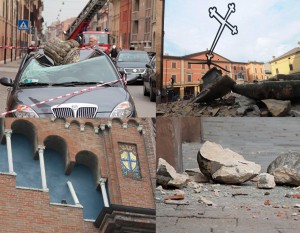
St. Agostino Town Hall
Another strong earthquake hits Italian cultural heritage on May 20, 2012. Since now, PERPETUATE team has followed the damages only through by watching TV news and images on the net. But we will go on site soon. The first images of the earthquake show once again the high vulnerability of heritage buildings. Historical seismicity analyses (made by the Italian Institute of Geophysics and Vulcanology – www.ingv.it) have led us to notice that the zone have been shaken in the past by earthquakes, but that they were not too frequent. This type of seismicity is often troublesome, since induces the people to forget the effects of past earthquakes and thus produce particularly vulnerable constructions. The damage observable from the media seems to be related, in many cases, to building defects or, alternatively, to too confident approaches to building design of ancient builders. One of the most emblematic images is that of the town hall of S. Agostino (FE). The collapse of one of the wall (probably related to a in-plane and out-of-plane mixed mode) occurred in a part of the building in which floors lack (probably a boardroom in which builders wanted to enlarge the space by doubling the height of the hall).
The earthquake hit in particular churches and towers. This is not a news. Many Italian earthquakes revealed the high vulnerability of these architectonic assets, mainly related to the presence of large hall without connecting walls and floors (in the case of churches) and to their height (in the case of towers). As usual, most of damage in churches seems to be produced by out-of-plane behaviour of the walls (in particular façades), related to their slenderness and lack of connections . This latter, in this region, have been probably further increased by the use of brick masonry of good quality, that induces builders to reduce the thickness of the wall elements (this may be fine for vertical loads but not for seismic horizontal ones). On the towers, mainly shear damage mechanisms are observable. This may be explained by observing the architectural shape of these buildings, that are quite squat. In some cases, only the bell cell has been hit , as observed in many other earthquakes.

Artistic assets damaged by the earthquake
This earthquake finally points out the vulnerability of artistic assets. Many artistic assets were damaged by this earthquake. Most of them are free-standing elements that evidently started to oscillate and then overturned on the ground. Since the study of seismic behaviour of artistic elements is one of the topic of PERPETUATE project, the team will analyze in details this kind of damage in the near future.
 Add to Google
Add to Google
